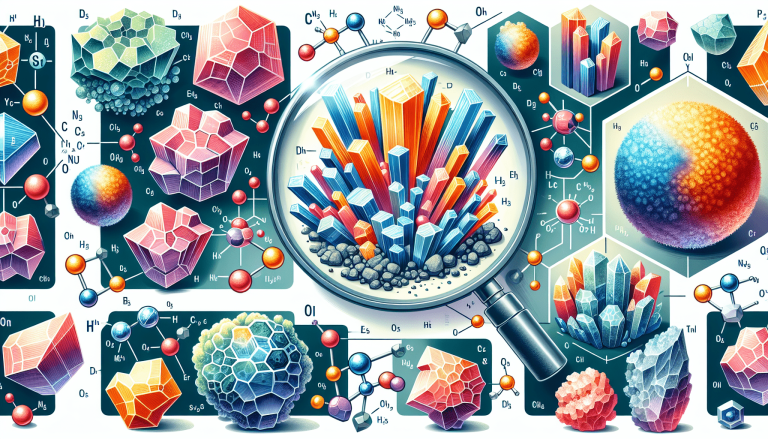How Can Mineral Chemical Properties Be Tested?
So you’re curious about how to test mineral chemical properties? Well, you’ve come to the right place! In this article, we’ll explore various methods and techniques used by scientists to determine the chemical composition and properties of minerals. From spectrometry to X-ray diffraction, there are a plethora of fascinating ways to analyze and understand the characteristics of minerals. Whether you’re a mineral enthusiast or just looking to expand your knowledge, stick around as we delve into the world of mineral testing.
Introduction
When it comes to studying minerals, it is essential to understand their physical and chemical properties thoroughly. These properties can provide valuable information about the composition and structure of minerals, as well as their potential uses. This article will explore various testing methods used to analyze the physical and chemical properties of minerals, including color, streak, luster, hardness, cleavage, fracture, specific gravity, crystal shape, reaction with acid, reaction with water, reaction with heat, spectroscopy analysis, atomic absorption spectrometry (AAS), inductively coupled plasma optical emission spectrometry (ICP-OES), inductively coupled plasma mass spectrometry (ICP-MS), X-ray fluorescence spectrometry (XRF), and electron microprobe analysis (EPMA).
Physical Properties Testing
Color
Color is often the first observation made when examining a mineral, and it can provide valuable preliminary information. Minerals can come in a wide range of colors – from bright and vibrant to dull and earthy. The color of a mineral can be influenced by impurities or chemical substitutions within its crystalline structure.
Streak
Streak refers to the color of a powdered mineral when it is rubbed against a rough surface. This is usually done by dragging the mineral across an unglazed porcelain plate or streak plate. The resulting streak color can be different from the color of the mineral itself. For example, a mineral with a yellow color may leave a white streak. Streak can help differentiate minerals with similar colors but different compositions.
Luster
Luster describes the way a mineral reflects light. It can be classified as metallic or non-metallic. Metallic luster is characteristic of minerals that appear shiny, like metals. Non-metallic luster, on the other hand, can range from vitreous (glassy) to silky, pearly, or even earthy.
Hardness
Hardness refers to a mineral’s resistance to being scratched. It is determined by testing the mineral’s ability to scratch or be scratched by other commonly known minerals. The Mohs scale of mineral hardness is widely used in this assessment, ranging from 1 (softest) to 10 (hardest). For example, talc has a hardness of 1, while diamond has the highest hardness of 10.
Cleavage
Cleavage refers to a mineral’s tendency to break along distinct planes of weakness due to its atomic structure. This property is related to the arrangement of atoms within a mineral’s crystal lattice. Some minerals may exhibit perfect cleavage, where they break into smooth and flat surfaces, while others may have poor or no cleavage at all.
Fracture
Fracture refers to the way a mineral breaks when it is not along a cleavage plane. Unlike cleavage, fracture can result in irregular or jagged surfaces. Common fracture types include conchoidal (shell-like) and uneven (rough and irregular).
Specific Gravity
Specific gravity measures the density of a mineral compared to the density of water. It is determined by comparing the weight of a mineral to an equal volume of water. Specific gravity can provide clues about a mineral’s composition and can help distinguish between minerals with similar appearances.
Crystal Shape
Crystal shape, or crystal habit, refers to the external shape or form of a mineral’s crystal. Different minerals can exhibit distinct crystal shapes, such as cubic, prismatic, tabular, or acicular. Crystal shape can be influenced by the conditions under which the mineral forms, including temperature and pressure.

Chemical Reactions Testing
Reaction with Acid
Testing a mineral’s reaction with acid can reveal its chemical composition. Some minerals, like calcite, effervesce or fizz when they come in contact with a weak acid like vinegar, indicating the presence of carbonate ions. On the other hand, minerals like quartz show no reaction with acid, suggesting they are composed of different chemical compounds.
Reaction with Water
Some minerals can react with water, either by dissolving or undergoing a chemical change. For example, halite, or rock salt, readily dissolves in water, while minerals like gypsum can undergo hydration and form a new compound. These reactions can help identify specific minerals and provide insights into their behavior in natural environments.
Reaction with Heat
Applying heat to a mineral can cause certain physical or chemical changes. Minerals can exhibit characteristics like changes in color, texture, or the release of water. Heating minerals can also help determine their stability or identify specific minerals present in a rock or mineral sample.
Spectroscopy Analysis
X-ray Diffraction
X-ray diffraction is a powerful technique used to determine the crystal structure of minerals. By directing X-rays onto a sample, the resulting diffraction pattern can provide information about the arrangement of atoms within the crystal lattice, helping identify the mineral and its composition.
Infrared Spectroscopy
Infrared spectroscopy measures the absorption and transmission of infrared light by a mineral sample. Different minerals have unique infrared spectra due to the vibrations of their chemical bonds. By analyzing these spectra, mineralogists can identify specific minerals and gain insight into their molecular structure.
UV-Visible Spectroscopy
UV-Visible spectroscopy measures the absorption and reflection of ultraviolet and visible light by minerals. Each mineral has a distinct absorption spectrum based on the electronic transitions occurring within its atomic structure. UV-Visible spectroscopy can aid in identifying minerals and studying their electronic properties.

Atomic Absorption Spectrometry (AAS)
Atomic absorption spectrometry (AAS) is a technique used to determine the concentrations of various elements present in a mineral sample. AAS involves atomizing the sample and passing light through it to measure the absorption of specific wavelengths. This allows for the quantitative analysis of elements, providing information about the mineral’s composition.
Inductively Coupled Plasma Optical Emission Spectrometry (ICP-OES)
Inductively coupled plasma optical emission spectrometry (ICP-OES) is a technique used to determine the elemental composition of a mineral sample. It involves nebulizing the sample and introducing it into an inductively coupled plasma. The emitted light from the excited atoms can be analyzed to determine the concentrations of specific elements present in the sample.
Inductively Coupled Plasma Mass Spectrometry (ICP-MS)
Inductively coupled plasma mass spectrometry (ICP-MS) is a highly sensitive technique used to measure the elemental composition of minerals. It combines the capabilities of ICP-OES with mass spectrometry, allowing for the determination of both major and trace elements. ICP-MS is widely used in mineral exploration, environmental analysis, and research.
X-ray Fluorescence Spectrometry (XRF)
X-ray fluorescence spectrometry (XRF) is a non-destructive technique used to determine the elemental composition of minerals. XRF involves irradiating the sample with X-rays, causing the emission of characteristic X-rays from the atoms in the sample. By analyzing the emitted X-rays, mineralogists can identify and quantify the elements present.
Electron Microprobe Analysis (EPMA)
Electron microprobe analysis (EPMA) is a technique used to determine the chemical composition of minerals with high spatial resolution. It involves bombarding a mineral sample with a focused electron beam and analyzing the characteristic X-rays emitted by the sample. EPMA can provide precise elemental composition data, making it a valuable tool in mineralogical research.
Conclusion
Understanding the physical and chemical properties of minerals is crucial for mineralogists and geologists. By employing a combination of testing methods, including color, streak, luster, hardness, cleavage, fracture, specific gravity, crystal shape, chemical reactions, spectroscopy analysis, and spectrometry techniques, researchers can gain valuable insights into the composition and behavior of minerals. These techniques enable the identification of minerals, the measurement of elemental concentrations, and the determination of crystal structures, contributing to our understanding of Earth’s geology and the potential applications of minerals in various industries.







